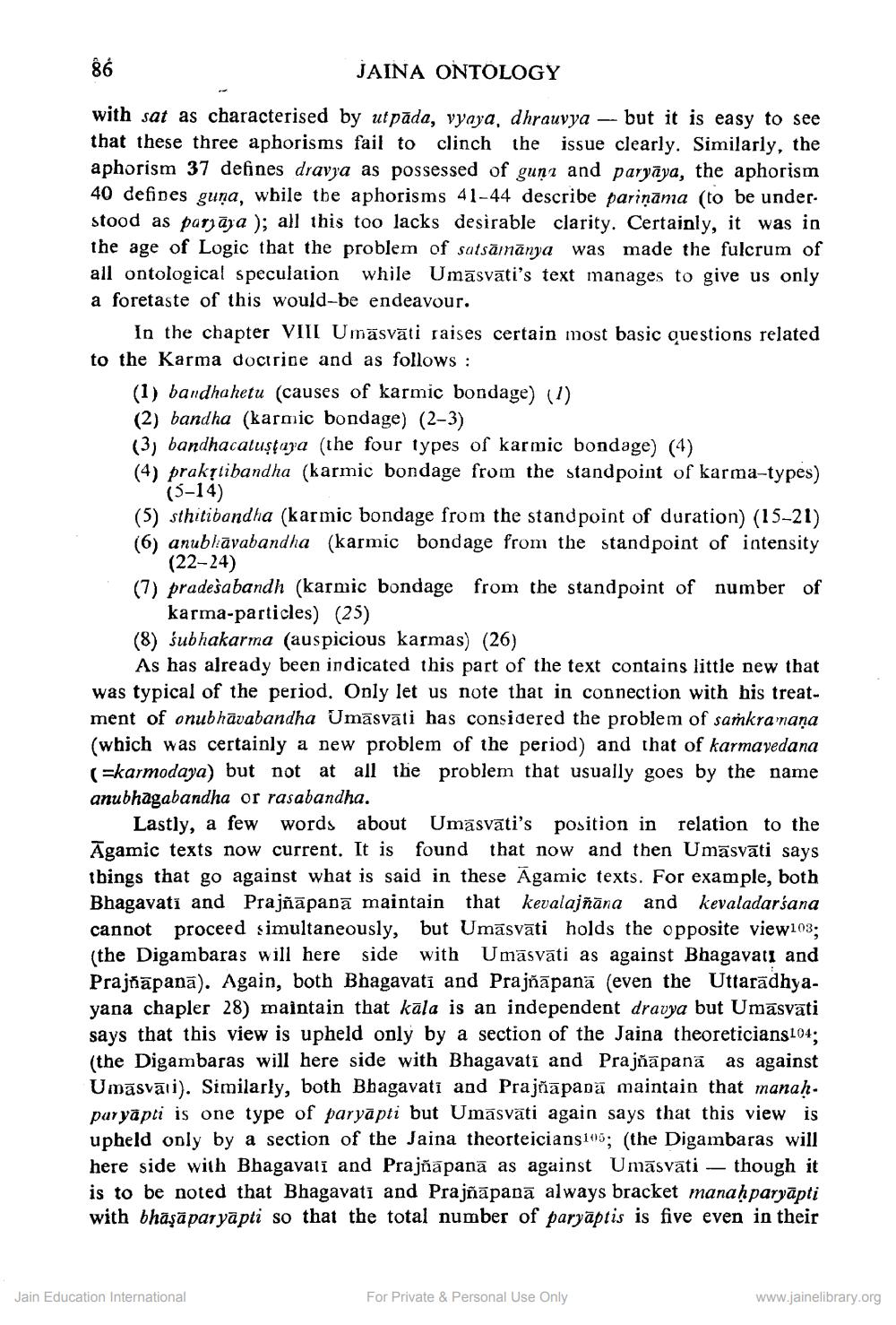________________
86
JAINA ONTOLOGY
with sat as characterised by ut pāda, vyaya, dhrauvya -- but it is easy to see that these three aphorisms fail to clinch the issue clearly. Similarly, the aphorism 37 defines dravja as possessed of gunı and paryāya, the aphorism 40 defines guna, while the aphorisms 41-44 describe parināma (to be understood as paryāya ); all this too lacks desirable clarity. Certainly, it was in the age of Logic that the problem of satsāmānya was made the fulcrum of all ontological speculation while Umāsvāti's text manages to give us only a foretaste of this would-be endeavour.
In the chapter VIII Umāsvāti raises certain most basic questions related to the Karma doctrine and as follows:
(1) bandhahetu (causes of karmic bondage) (1) (2) bandha (karmic bondage) (2-3) (3) bandhacatustaya (the four types of karmic bondage) (4) (4) prakrtibandha (karmic bondage from the standpoint of karma-types)
(5-14) (5) sthitibandha (karmic bondage from the standpoint of duration) (15-21) (6) anublāvabandha (karmic bondage from the standpoint of intensity
(22-24) (7) pradesabandh (karmic bondage from the standpoint of number of
karma-particles) (25) (8) śubhakarma (auspicious karmas) (26)
As has already been indicated this part of the text contains little new that was typical of the period. Only let us note that in connection with his treatment of onubhāvabandha Umāsvāti has considered the problem of samkramana (which was certainly a new problem of the period) and that of karmavedana (=karmodaya) but not at all the problem that usually goes by the name anubhagabandha or rasabandha.
Lastly, a few words about Umāsvāti's position in relation to the Āgamic texts now current. It is found that now and then Umāsvāti says tbings that go against what is said in these Agamic texts. For example, both Bhagavati and Prajñāpanā maintain that kevalajñāna and kevaladarśana cannot proceed simultaneously, but Umāsvāti holds the opposite view103; (the Digambaras will here side with Umāsvāti as against Bhagavati and Prajñāpanā). Again, both Bhagavati and Prajñāpanā (even the Uttaradhya. yana chapler 28) maintain that kala is an independent dravya but Umāsvāti says that this view is upheld only by a section of the Jaina theoreticians104; (the Digambaras will here side with Bhagavati and Prajñāpanā as against Umāsvāli). Similarly, both Bhagavati and Prajñāpanā maintain that manah. par yapti is one type of paryāpti but Umāsvāti again says that this view is upheld only by a section of the Jaina theorteicians105; (the Digambaras will here side with Bhagavali and Prajñāpanā as against Umāsvati — though it is to be noted that Bhagavati and Prajñāpanā always bracket manah paryāpti with bhāşāpar yāpti so that the total number of paryāptis is five even in their
Jain Education International
For Private & Personal Use Only
www.jainelibrary.org




